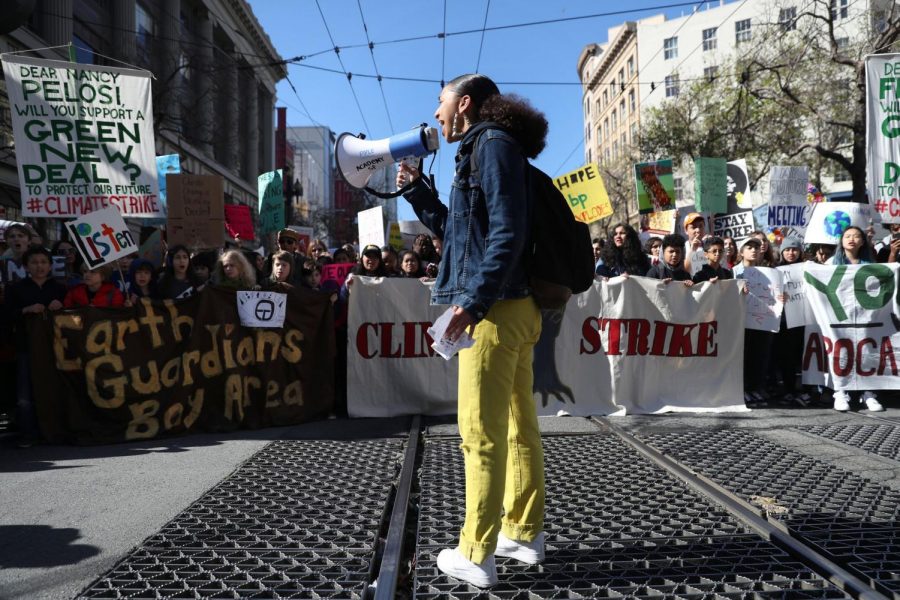Climate Strikes
People around the world protest inaction regarding climate change

Striking is not just for fair wages anymore! Following the model of refusing to work to enact change, millions around the world are striking for the planet.
The biggest climate strike in world history occurred during the week of September 20th, with around 7.6 million people participating in 185 countries. The idea for these climate strikes began when Greta Thunberg sat outside the Swedish parliament for three weeks in August 2019, protesting in order to encourage her government to act on the issue of climate change. After three weeks, Thunberg decided to strike every Friday, leading to the movement Fridays For Future. Fridays For Future encourage children to leave school, create a sign, and peacefully protest in front of their town hall every Friday. Other organizations, like 350.org, are addressing adults, asking them to join the strikes alongside children.
Greta Thunberg is the leading face of this movement, speaking on multiple occasions about this issue. She is well known for her blunt way of speaking in public and to political leaders. Thunberg has spoken to many world leaders, most notably, her speech to Congress on September 18, 2019, and her second address to the United Nations on September 23, 2019. Instead of giving her testimony to the House of Representatives Select Committee on Climate Crisis, Thunberg delivered an eight-sentence statement urging leaders to look at the science and act on the science, not on her words. She constantly states that adults should not be giving hope to the next generation to fix this problem, but that they should act now. In an excerpt from Thunberg’s speech to the United Nations Climate Action Summit in New York City on September 23 of this year, she says, “You’re failing us, but young people are starting to understand your betrayal. The eyes of all future generations are upon you. And if you choose to fail us, I say we will never forgive you.”
Why is climate change such a big problem? Merriam-Webster defines climate change as significant and long-lasting changes to the Earth’s climate and weather patterns. While Earth has gone through changes in the climate before, the Ice Age, the warming of the Earth that ended Bronze Age civilization, and others, those climate changes were caused by variations in the Earth’s orbit. The reason why climate change that is going on now is so concerning is that it is not just being caused by orbital variations. The main reason for the current climate change is greenhouse gases and overpopulation. Greenhouse gases are carbon dioxide (from burning fossil fuels), methane (from production and transportation of coal, natural gases, and oil), nitrous oxide (from agricultural and industrial activities and combustion of fossil fuels and solid waste), and fluorinated gases (which are synthetic and come from numerous industrial activities). These greenhouse gases trap heat in the atmosphere causing temperatures to rise. The global temperature has risen by 1.9 degrees Fahrenheit since 1880. The rise in temperature is causing glacier ice to melt, raising sea levels 3.3 millimeters per year, then flooding coastal towns. Dissolved carbon dioxide has increased the surface acidity of the oceans by 30 percent since the late 18th century. While these numbers may seem small, in the grand scheme of things, they have a big impact.
What is the good news about all of this? Scientists are pretty sure we can solve this massive global problem if we act now. Mainly by switching to renewable energy over fossil fuels, we may be able to slow down climate change. But how is this change going to be done if lawmakers do not act fast enough? That is where climate strikes come in. If enough people leave work and school to participate in these strikes, the issue will be a bigger priority to others, because money will be lost. The climate strikes mirror the two-week newsboys’ strike in New York in 1899, where the children selling newspapers went on strike for better wages and full buybacks on the papers they did not sell. The children’s strike in 1899 was successful because it caused Pulitzer’s paper to dramatically decrease circulation. Most strikes in U.S. history have been over fair wages and harmful working conditions and only been against one company or boss. While the world climate strikes are not a traditional strike, they are trying to accomplish the same goal all strikes have, get the people in power to notice the issue they are striking about.
The world climate strike in September is not going to be the last one. Thunberg has been traveling around North and South America to strike with other children every Friday. She says she and others will continue to strike until the problem had been solved. Thunberg announced on Instagram October 13th that there will be another global climate strike on November 29th, since leaders have not taken immediate action and listened to the science. Will these climate strikes be successful? Only history knows, but let us hope that history is shining brightly on Thunberg and the millions that join her on her quest to combat climate change. In the world of fictional striker Jack Kelly, “Now is the time to seize the day!”







